Contraception
Also called birth control, contraception allows you to enjoy sex while reducing your risk of pregnancy. You have lots of options when it comes to contraception. The facts below can help you make the best choice for you.


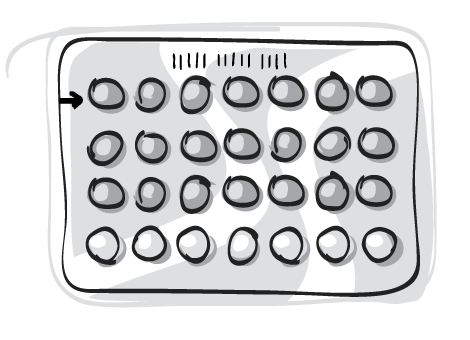
21-day packs - You take one pill at the same time each day for three weeks in a row. No pills are taken in the fourth week (this is when most people get their period). After one pill-free week, you start a new 21-day pack.
28-day packs - When you finish one pack, you start a new pack right away. The seven extra pills in a 28-day pack are reminder pills that don’t contain any hormones (they are only there to help you stay on track). Most people will get their period in the last week of a 28-day pill pack.
Some brands of oral contraceptive pills can be taken continuously (with no week off) to avoid or delay your period. They don’t all work this way, so check with your health care provider before you try.
Progestin-only Pills - (Mini Pills) can be used by people who can’t take estrogen. Progestin-only pills come in 28-day packs and all 28 pills contain the hormone progestin, preventing pregnancy.
The pill is highly effective and reversible (not permanent). It prevents pregnancy by:
Most Oral Contraceptive Pills contain two types of hormones (estrogen and progestin), preventing pregnancy. Pill packs come in 21 or 28 pills and many different brands, each with different hormone strengths. You will need to remember to take your pill at the same time every day.
You can start using the pill at any time. Depending on which day in your menstrual cycle you start, and on which pill you choose, it can take up to 7 days before the pill is effective in preventing pregnancy.
You’ll need to use condoms until the pill has been in your body long enough to prevent pregnancy.

Effectiveness of the pill can be reduced by other medications including:
If you are unsure about a possible interaction between your medications, talk with your health care provider.
Sticking to a schedule keeps the right level of hormones in your body to prevent pregnancy.
Meaning 90 out of 1000 people using the pill typically will get pregnant in a year.
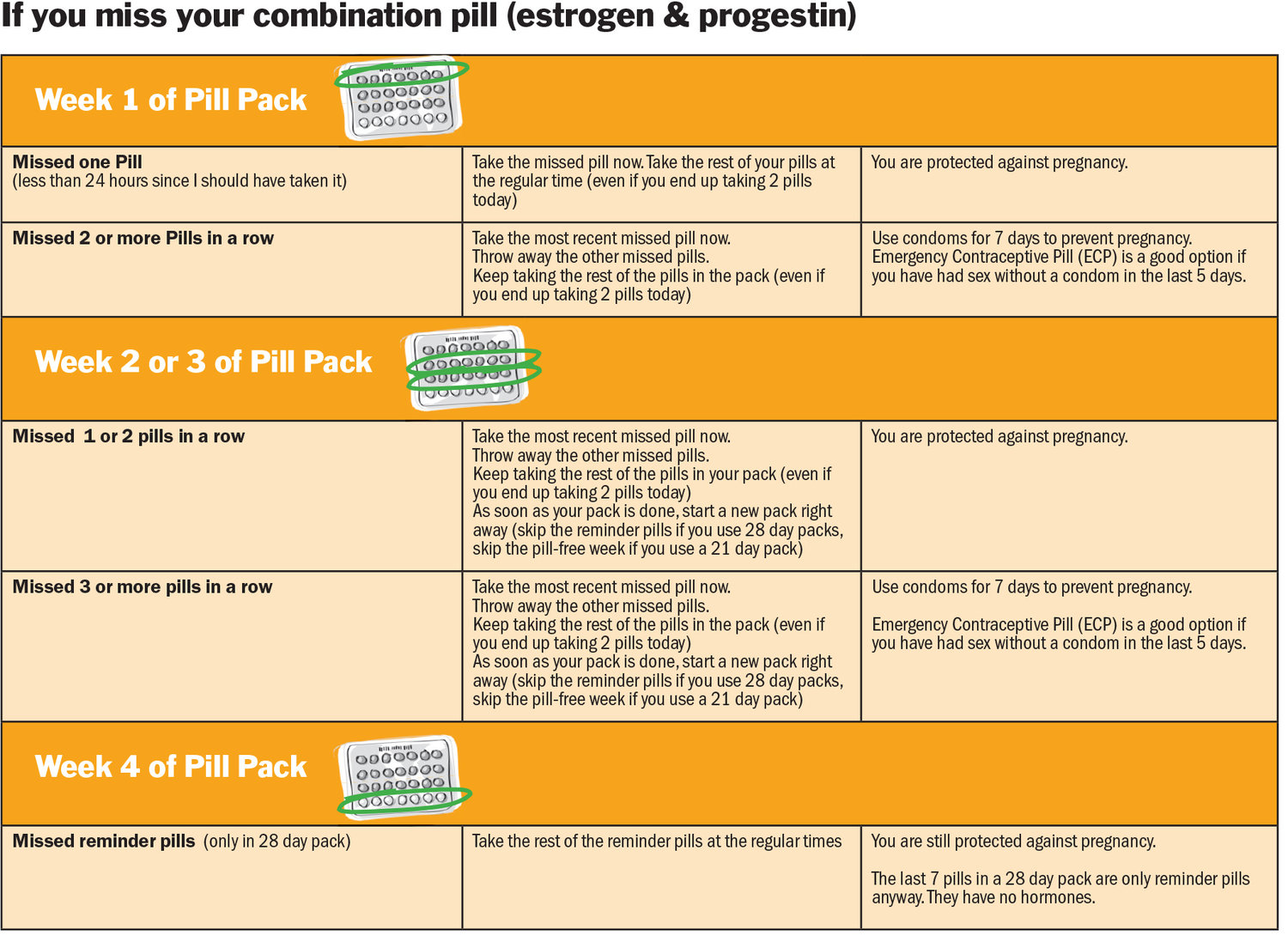

The pill works best when you take it at the same time every day. If you need a reminder, there are lots of great apps available!
What to do when you forget to take your pill depends a lot on which kind you take, combination pills (with both estrogen and progestin) or progestin-only pills. If you’re not sure which one you are on, contact your health care provider.
Some people get nausea or spotting when they miss an oral contraceptive pill. These symptoms usually go away very quickly.
If you aren’t sure what to do when you have missed taking birth control pills, talk with your health care provider.

Some side effects from the pill are more desirable than others. Many of the less desirable ones often get better after you have been on the pill for a few months. Side effects can include: more regular periods, less menstrual flow and cramping, less acne, reduced risk of endometrial and ovarian cancer, weakening of bones (decreased bone density which may return to normal when you stop taking the pill), irregular bleeding, headaches, bloating, breast tenderness, nausea (it can help to take the pill at bedtime), higher risk of blood clots.
Some side effects can be warning signs of something more serious. If you have any of the following symptoms, let your health care provider know as soon as possible: a new lump in your breast, sudden severe headache, soreness in your leg, severe chest or stomach pain, missing a period if you have always been regular, yellow eyes.
Some side effects from the pill are more desirable than others. Many of the less desirable ones often get better after you have been on the pill for a few months.
The oral contraceptive pill is very safe for most people. Some health conditions can increase the risk of serious side effects. Check with your health care provider before taking the contraceptive pill if you are a smoker over 35 years old or have any of these:
The oral contraceptive pill is very safe for most people. Some health conditions can increase the risk of serious side effects. Check with a health care professional before taking the birth control pill if you are a smoker over 35 years old or have any of these...
If you decide you want to become pregnant, simply stop taking your oral contraceptive pill. It may take between one to two months before your ovulation returns to normal.
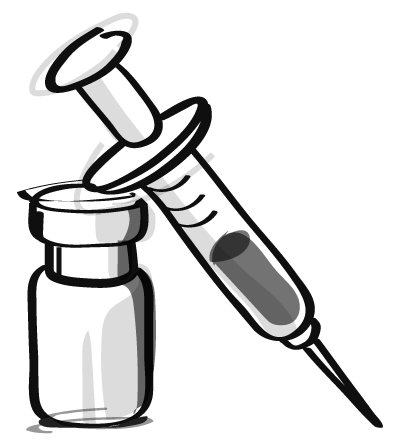
The progestin-only contraceptive shot can be used by people who can’t take estrogen. Depo Provera is highly effective, longer lasting and reversible (not permanent). It prevents pregnancy by:
Depo Provera contains the hormone Progestin.
A small injection is given in the muscle of your shoulder or the cheek of your bum every 12 weeks. You will have to a see a health care provider every three months for your injection, but there is nothing to remember every day.
You can start on Depo Provera any time. If your first injection is given in the first five days of your menstrual period, Depo Provera is effective immediately.
If your first injection is given at another time in your menstrual cycle, you’ll need to use condoms for 3 weeks until the injection has been in your system long enough for it to prevent pregnancy.
Your health care provider may ask you to take a pregnancy test before you start on Depo Provera.
Sticking to a schedule keeps the right level of hormones in your body to prevent pregnancy.
Meaning 60 out of 1000 people using the Depo Provera typically will get pregnant in a year.
Effectiveness is not affected by other medications.
If it has been more than 13 weeks since your last injection, use condoms to prevent pregnancy and get your injection as soon as possible. Your health care provider may ask you to take a pregnancy test before you get your Depo Provera injection. You’ll need to use condoms for 3 weeks after your injection to make sure you’re protected until the medication has been in your system long enough to prevent pregnancy.
Emergency Contraception (EC) is a good option if you have had sex without a condom in the last 5 days.
If you need a reminder, there are lots of great apps available!
If you aren’t sure what to do when you have missed your injection, talk with your health care provider
Some side effects from Depo Provera are more desirable than others. Many of the less desirable ones often get better after you have been taking the injection for a few months. Side effects can include: changes to menstrual periods (reduced menstrual cramps, periods become irregular, heavier, lighter, or stop all together), irregular ovulation for 6-8 months after last injection (this can delay the ability to get pregnant after you stop taking Depo Provera), weakening of bones (decreased bone density which may return to normal when you stop taking the injection), reduced risk of endometrial cancer and fibromas, hormonal side effects (acne, headaches, beast sensitivity, worsening of depression, change in sex drive, change in appetite, weight gain).
Some side effects can be warning signs of something more serious. If you have any of the following symptoms, you should let your health care provider know as soon as possible: a new lump in your breast, severe or worsening depression, severe headache with aura (seeing spots of bright light), severe redness, swelling or discharge at the injection site, vaginal bleeding that is much heavier or for much longer than normal, yellow eyes.
Depo Provera is only effective at preventing pregnancy for three months (12-13 weeks), but side effects of the medication may last longer.
Depo Provera is only effective at preventing pregnancy for three months (12-13 weeks), but the side effects of the medication may continue for longer.
Some side effects from Depo Provera are more desirable than others. Many of the less desirable ones often get better after you have been on Depo Provera for a few months.
The injectable contraception Depo Provera is very safe for most people. Some health conditions can increase the risk of serious side effects. Depo Provera should not be taken if:
People with the following family history may require more frequent follow up with their doctor when taking injectable contraceptives:
Injectable contraception is very safe for most people. Some health conditions can increase the risk of serious side effects. Check with your health care professional before taking Depo Provera if you have any of these...
If you decide you want to become pregnant, simply stop taking the injection. It can take between 4-12 months before your ovulation returns to normal.
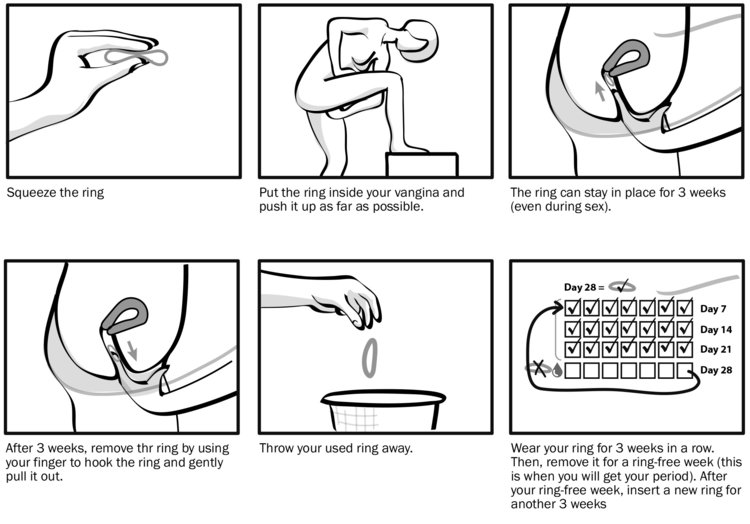
The vaginal ring is a small, soft, flexible, clear plastic ring you insert into your vagina (held in place by your vaginal walls). Most people find the ring easy to insert and can't feel it once it is in place. The ring slowly releases two types of hormones (estrogen and progestin), preventing pregnancy. You'll have to remember to change your ring each week, but there is nothing to remember every day.
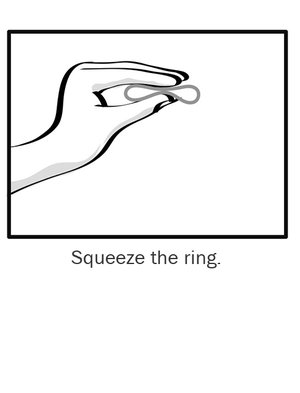
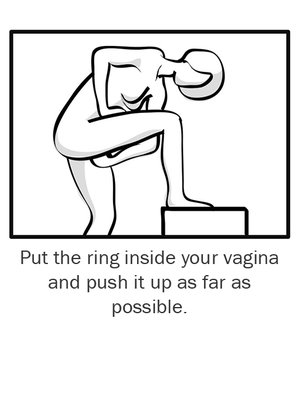
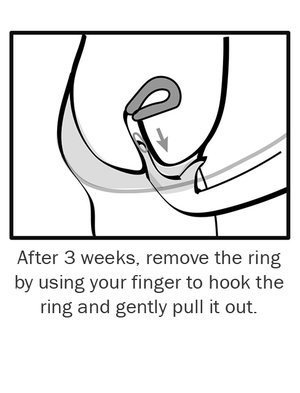
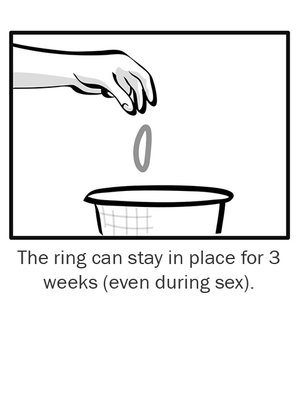
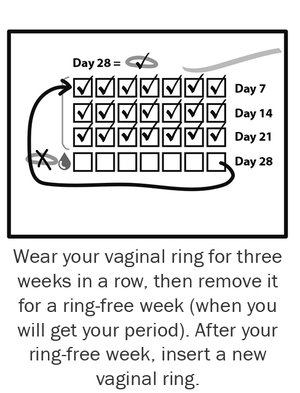
The vaginal ring is highly effective and refersible (not permanent). It prevents pregnancy by:
The vaginal ring is a small, soft, flexible, clear plastic ring you insert into your vagina (held in place by your vaginal walls). Most people find the ring easy to insert and can't feel it once it is in place. The ring slowly releases two types of hormones (estrogen and progestin), preventing pregnancy. You'll have to remember to change your ring each week, but there is nothing to remember every day.
You can start using the vaginal ring at any time. Depending on which day in your menstrual cycle you start, it can take up to 7 days before the vaginal ring is effective in preventing pregnancy.
You’ll need to use condoms until the ring has been in place long enough to prevent pregnancy.
The ring can interfere with the cervical cap, diaphragm, and sponge. These methods cannot be used along with the vaginal ring.
Effectiveness of the pill can be reduced by other medications including:
If you are unsure about a possible interaction between your medications, talk with your health care provider.
The vaginal ring may be slightly less effective for people with a high BMI (Body Mass Index). If you're concerned about how the ring will work in your body, ask you health care provider.
Sticking to a schedule keeps the right level of hormones in your body to prevent pregnancy.
Meaning 90 out of 1000 people using the vaginal ring typically will get pregnant in a year.
If your ring has been out for less than 3 hours: Wash the ring in cool water, insert it right away and keep it in until your scheduled ring removal day. You’re still protected from pregnancy.
If your ring has been out for more than 3 hours: Wash the ring in cool water, insert it right away and keep it in until your next scheduled ring removal day. Use condoms for the next 7 days until the ring has been in place long enough to prevent pregnancy. Emergency Contraception (EC) is a good option to prevent pregnancy if you had sex without a condom in the last five days.
If your ring has been out for less than 3 hours: Wash the ring in cool water, insert it right away and keep it in until your scheduled ring removal day. You’re still protected from pregnancy.
If your ring has been out for 3 to 72 hours: Wash the ring in cool water, insert it right away and keep it in until your next scheduled ring removal day. At week 4, begin a new contraception cycle with a new ring right away. Skip your ring-free week (you may miss your period, or have spotting). You’re still protected from pregnancy.
If your ring has been out for more than 72 hours: Wash the ring in cool water, insert it right away and keep it in until your next scheduled ring removal day. At week 4, begin a new contraception cycle with a new ring right away. Skip your ring-free week (you may miss your period, or have spotting). Use condoms for the next 7 days until the ring has been in place long enough to prevent pregnancy. Emergency Contraception (EC) is a good option to prevent pregnancy if you had sex without a condom in the last five days.
If you inserted your ring 21 to 27 days ago – This should be your ring-free week, so remove your ring right away and finish your regular ring-free week. Insert a new ring at the end of your ring-free week. Your period may be a bit off schedule. Insert your new ring on time, even if your period isn’t finished yet. You’re still protected from pregnancy.
If you inserted your ring 28 to 35 days ago – Remove your ring and insert a new ring right away to start a new contraception cycle. Skip your ring-free week (you may miss your period, or have spotting). You’re still protected from pregnancy.
If you inserted your ring more than 35 days ago - Remove your ring and insert a new ring right away to start a new contraception cycle. Skip your ring-free week (you may miss your period, or have spotting). Use condoms for the next 7 days until the ring has been in place long enough to prevent pregnancy. Emergency Contraception (EC) is a good option to prevent pregnancy if you had sex without a condom in the last five days.
If there is a possibility you may have become pregnant, you should take a pregnancy test before inserting a new ring to begin a new cycle. If you aren't’ sure what to do, talk with your health care provider or visit www.sexlifesask.ca for more information.
Emergency Contraception (EC) is a good option if you have had sex without a condom in the last 5 days.
If you need a reminder, there are lots of great apps available!
If you aren’t sure what to do if there’s a problem with your ring, talk with your health care provider.
Some side effects from the vaginal ring are more desirable than others. Many of the less desirable ones often get better after you have been using the vaginal ring for a few months. Side effects can include: more regular periods, less menstrual flow and cramping, reduced risk of endometrial, ovarian, and cervical cancer, reduced risk of fibroids and ovarian cysts, irregular bleeding, headaches, nausea, breast tenderness, vaginal irritation or discharge, and decreased sexual desire.
Some side effects can be warning signs of something more serious. If you have any of the following symptoms, you should let your health care provider know as soon as possible: a new lump in your breast, severe headache, soreness in your leg, severe chest or stomach pain, missing a period if you have always been regular, yellow eyes.
Some side effects from the vaginal ring are more desirable than others. Many of the less desirable ones often get better after you have been on the ring for a few months.
The vaginal ring is safe for most people. Some health conditions can increase the risk of serious side effects. Check with your health care provider before using the vaginal ring if you are a smoker or over 35 years old or have any of these:
The vaginal ring is very safe for most people. Some health conditions can increase the risk of serious side effects. Check with a health care provider before using the vaginal ring if you are a smoker over 35 years old or have any of these . . .
If you decide you want to become pregnant, simply remove your vaginal ring. It may take one to two months before your ovulation returns to normal.
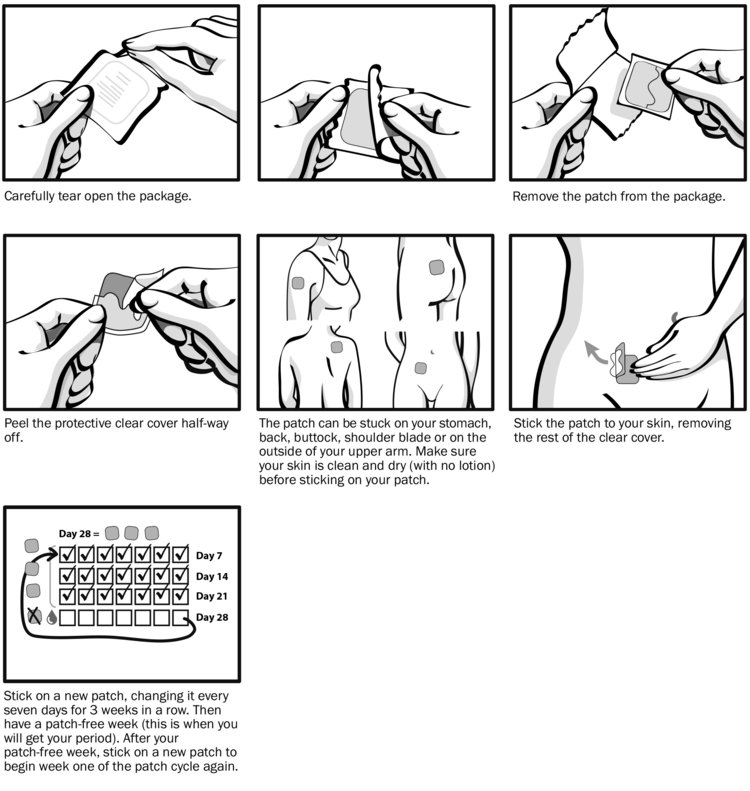
The patch is a small beige square that sticks to the skin and slowly releases two types of hormones (estrogen and progestin), preventing pregnancy. It's very sticky and can be worn in the shower, swimming or exercising. You'll have to remember to change your patch every three weeks, but there is nothing to remember every day.
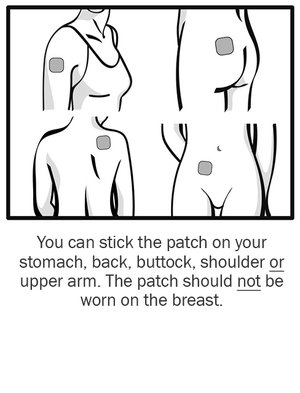
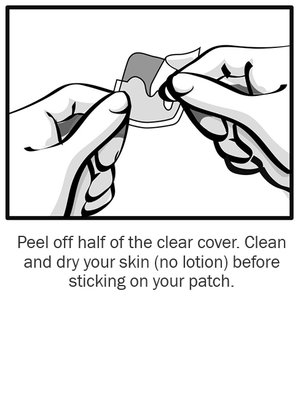
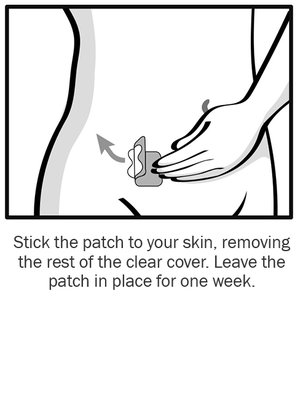
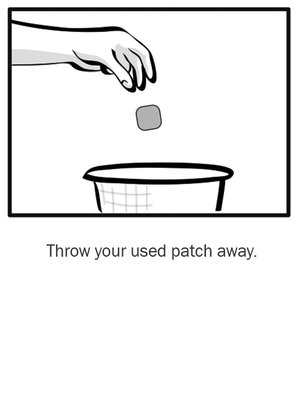
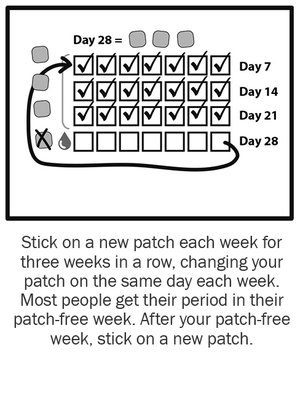
The patch is highly effective and reversible (not permanent). It prevents pregnancy by:
The patch is a small beige square that sticks to the skin and slowly releases two types of hormones (estrogen and progestin), preventing pregnancy. It's very sticky and can be worn in the shower, swimming or exercising. You'll have to remember to change your patch every three weeks, but there is nothing to remember every day.
You can start using the contraceptive patch at any time. Depending on which day in your menstrual cycle you start, it can take up to 7 days before the patch is effective in preventing pregnancy.
You’ll need to use condoms until you the patch has been in place long enough to prevent pregnancy.

Effectiveness of the patch can be reduced by other medications including:
If you are unsure about a possible interaction between your medications, talk with your health care provider.
The patch may be slightly less effective for people with a high BMI (Body Mass Index). If you are concerned about how the patch will work in your body, ask your health care provider.
Sticking to a schedule keeps the right level of hormones in your body to prevent pregnancy.
Meaning 90 out of 1000 people using the patch typically will get pregnant in a year.
If your patch has fallen off for 48 hours or less, simply stick it back on right away. If the patch won’t re-stick, use a new patch, then change the patch on your regular patch change day.
If your patch has fallen off for more than 48 hours, apply a new patch. Count today as day one of a nw four-week patch cycle. You’ll need to use condoms to for 7 days, until the patch has been in place long enough to prevent pregnancy.
The emergency Contraception Pill (ECP) is a good option to prevent pregnancy if you had sex without a condom in the last five days before you realized that your patch had fallen off.
The Emergency Contraception Pill (ECP) is a good option to prevent pregnancy if you had sex without a condom in the last five days before you realized that you were late applying a new patch.
The Emergency Contraception Pill (ECP) is a good option to prevent pregnancy if you had sex without a condom in the last five days before you realized that you were late applying a new patch.
If there is a possibility you may have become pregnant, you should take a pregnancy test before applying a new patch to begin a new cycle.
Emergency Contraception (EC) is a good option if you have had sex without a condom in the last 5 days.
If you need a reminder, there are lots of great apps available!
If you aren’t sure what to do if there’s a problem with your patch, talk to your health care provider.
Some side effects from the patch are more desirable than others. Many of the less desirable ones often get better after you have been using the patch for a few months. Side effects can include: more regular periods, less menstrual flow and cramping, reduced risk of endometrial, ovarian, and cervical cancer, reduced risk of fibroids and ovarian cysts, irregular bleeding, headaches, nausea, breast tenderness, skin irritation.
Some side effects can be warning signs of something more serious. If you have any of the following symptoms, let your health care provider know as soon as possible: a new lump in your breast, severe headache, soreness in your leg, severe chest or stomach pain, missing a period if you have always been regular, yellow eyes.
Some side effects from the contraceptive patch are more desirable than others. Many of the less desirable ones often get better after you have been using the patch for a few months.
The contraceptive patch is very safe for most people. Some health conditions can increase the risk of serious side effects. Check with a health care provider before using the patch if you are a smoker over 35 years old or have any of these:
The contraceptive patch is very safe for most people. Some health conditions can increase the risk of serious side effects. Check with a health care provider before using the contraceptive patch if you are a smoker over 35 years old or have any of these . . .
If you decide you want to become pregnant, simply remove your patch. It may take one to two months before your ovulation returns to normal.

Intrauterine Device (IUD) is a small t-shaped device inserted into the uterus by a health care provider. There are two types of IUD. The Copper intrauterine device (Cu-IUD) which does not contain hormones, and the levonorgestrel-releasing intrauterine system (LNG-IUS), which contains the hormone progestin. Either kind of IUD can be used by women who can’t take estrogen
The Copper IUD (Cu-IUD) prevents pregnancy by preventing sperm from reaching the egg. Sperm don’t like copper, so when an IUD is placed in your uterus sperm won’t travel there.
The hormone releasing IUD, or intrauterine system (LNG-IUS) prevents pregnancy by:
Depending on the type of IUD you chose, it will prevent pregnancy for 3-12 years. It is not permanent. If you decide you want to become pregnant, a health care provider can easily remove your IUD.
Intrauterine Device (IUD) is a small t-shaped device inserted into the uterus by a health care provider. There are two types of IUD. The Copper intrauterine device (Cu-IUD) which does not contain hormones, and the levonorgestrel-releasing intrauterine system (LNG-IUS), which contains the hormone progestin. Either kind of IUD can be used by people who can’t take estrogen.

At an appointment, your health care provider will ask you questions about your medical history, perform a quick exam of your vagina, cervix and uterus, and test you for STIs (if you haven’t had a recent test already). Some sexual health clinics have IUDs available to purchase on site. But, most of the time, you will be given a prescription to fill at a pharmacy, then return for a second appointment to have your IUD inserted.
Inserting your IUD only takes about 5 minutes. Your health care provider will use a speculum and a special inserter to place your IUD through your cervix and into your uterus. Your IUD can be inserted at any time during your menstrual cycle. Some people find the insertion of an IUD slightly painful, but any discomfort doesn’t usually last very long. Some people have cramping and dizziness and need to take it easy for the rest of the day. Other people feel completely normal after their IUD is inserted.
Your IUD will remain inside your uterus and a string will stick out of your cervix 1-2 inches. This string allows your health care provider to remove your IUD later. You can feel for the string by putting your fingers inside your vagina and reaching up towards your cervix.
At an appointment, your health care provider will:
ask you questions about your medial history
perform a quick exam of your vagina, cervix and uterus
test you for STIs
IUDs are available for purchase at some sexual health clinics and by prescription at most pharmacies.
At a second appointment, your IUD will be inserted.
An IUD is one of the most effective types of birth control because there is nothing to remember daily, weekly or monthly.
IUD lasts for 3-12 years (depending on the brand).
Meaning 2 out of 1000 people using the IUD will get pregnant in a year.
Effectiveness is not affected by other medications.
It is rare for an IUD to fall out, but if it is going to happen it is usually in the first 3 months or during your menstrual cycle. If your IUD falls out, you are not protected against pregnancy.
Use condoms to prevent pregnancy until you are able to make an appointment with your health care provider to have a new IUD re-inserted.
If you have the IUD that fell out, bring it with you to your appointment, your health care provider will want to make sure it is complete, and no piece of the old IUD is left in your uterus before the new one is inserted.
Some side effects from the IUD are less desirable than others. Many of the less desirable ones often get better after your IUD has been in place for a few months. Side effects can include: changes to menstrual periods (periods become irregular, lighter, or stop all together) ,spotting, and increased menstrual cramps.
Some people feel discomfort when their IUD is inserted and cramping or backaches for a few days later.
Some side effects can be warming signs of something more serious. If you have any of the following symptoms, you should let your health care provider know as soon as possible: bad cramping or pain in your lower stomach, unexplained fever, chills or trouble breathing, your IUD is coming through your cervix or the length of your IUD string feels shorter or longer than before, pain or bleeding during sex, abnormal vaginal discharge, vaginal bleeding that is heavier than usual.
Some side effects from the IUD are more desirable than others. Many of the less desirable ones often get better after you have been using the IUD for a few months.
The IUD is very safe for most people. Some health conditions can increase the risk of serious side effects. You should not get an IUD if you:
The IUD is very safe for most people. Some health conditions can increase the risk of serious side effects.
If you decide you want to become pregnant, talk with your healthcare provider about the simple procedure to have your IUD removed.

The birth control implant is a soft, flexible plastic rod the size of a matchstick that is placed under the skin on the inner side of your upper arm . The birth control implant releases a hormone (progestin) that prevents ovulation.

At an appointment , your health care provider will:
· ask you questions about your medical history
· ask you to take a pregnancy test
· discuss risks and side effect to determine if the birth control implant is a good fit for you
Birth Control Implants are available by prescription at most pharmacies.
At a second appointment, your birth control implant will be inserted by your health care professional
The Birth Control Implant (Nexplanon) is one of the most effective types of birth control because there is nothing to remember daily, weekly or monthly.
The birth control implant lasts for 3 years
Meaning less than 1 out of 100 people using the birth control implant will get pregnant in a year.
Effectiveness is not affected by other medications
If at any time you cannot feel the birth control implant, contact your health care provider to have it checked. Use condoms to prevent pregnancy until you are able to make an appointment with your health care provider to confirm the implant is in place.
Some side effects from the birth control implant are more desirable than others. Many of the less desirable ones often get better after you have been using the implant for a few months.
The birth control implant is very safe for most people. Some health conditions can increase the risk of serious side effects.
If you decide you want to become pregnant, talk with your healthcare provider about the simple procedure to have your birth control implant removed.
Emergency Contraception might be a good option if:
You missed your birth control pill, patch, ring or injection
You didn’t use any contraception
You didn’t use a condom or the condom broke
You were the victim of sexual violence (sexual assault)
There are two types of emergency contraception to choose from in Canada, the Emergency Contraceptive Pill and the Copper Intrauterine Device.
The Emergency Contraceptive Pill works by preventing ovulation, preventing sperm from fertilizing the egg or stopping the egg from implanting in the uterine wall. The ECP pill will not harm you or the fetus if you are already pregnant. It is meant to be used occasionally, not as routine contraception.
ECP is most effective at preventing pregnancy when taken within 24 hours of unprotected vaginal sex. It can be taken up to five days after unprotected sex, but effectiveness declines the later it is taken. A BMI (body mass index) over 25 may reduce the effectiveness of ECP.
The emergency contraception pill can be safely used if you are breastfeeding. In most cases ECP will not affect your breast milk supply, and if it does, your supply should return to normal within a couple of days.
nausea, headaches, cramping, vomiting, dizziness, breast tenderness or your next period to be a bit early or late
The most common ECP’s in Saskatchewan are:
LNG-EC Pills (Plan B®) contains a progestin called lenonorgestrel
UPA-EC (ella ®) contains Ulipristal acetate 30mg
The Copper IUD is a small T-shaped copper device that is inserted into the uterus by a health care professional to prevent pregnancy. In addition to being a regular form of contraception, Copper IUD is also the most effective form of emergency contraception when inserted within 7 days of unprotected vaginal sex.
It is possible to become pregnant soon after you have been pregnant. If you are breastfeeding, you could begin ovulating as early as four weeks after childbirth. If you aren’t breastfeeding, ovulation could start even sooner (even before your menstrual cycle returns).